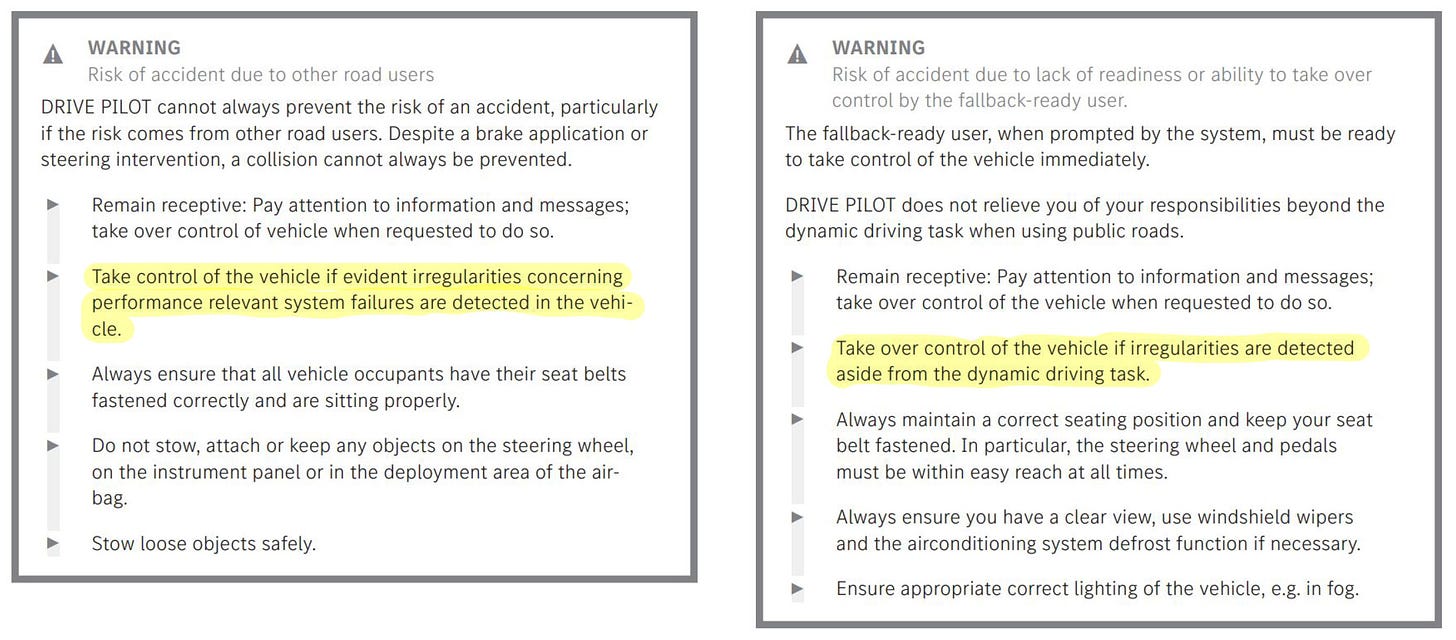Mercedes Benz DRIVE PILOT and driver blame
MB has softened their stance on Level 3 liability, but they still don’t really have your back when it matters.
Good news: Mercedes Benz has improved their position on driver liability.
Bad news: But they’re not there yet. A soft promise to pay insurance isn’t the biggest issue. Tort liability in a courtroom is.
MB is starting yet another round of “we take responsibility for crashes” for their Level 3 DRIVE PILOT traffic jam assist automation feature, approved for use in California & Nevada as a “Level 3” system and some places outside the US as an ALKS traffic jam assist system. (h/t to Susana Gallun for this gem promising they will cover insurance cost of crashes in Australia.)
Gone is the wording of the driver having to notice “irregularities .. in the traffic situation” while watching a movie on the dashboard. Because that was just plain stupid. And was an admission that they were selling an SAE Level 2+ system and not a Level 3 system, because Level 3 requires no driver attention to what is happening on the roadway.
Now MB has adopted terminology from SAE J3016. The driver “must take control of the vehicle if evident irregularities concerning performance relevant system failures are detected in the vehicle.” Straight out of J3016 Level 3 requirements. So that at least means they are consistent with the standard they invoke, and they are legit selling a Level 3 system according to their description. Too bad J3016 is not actually a safety standard and conformance to Level 3 does not bestow safety.

(Excerpt from Drive Pilot supplement: https://www.mbusa.com/content/dam/mb-nafta/us/owners/drive-pilot/QS_Sedan_Operators_Manual_US.pdf
There are two issues here. The first is what a “performance relevant system failure” inside the vehicle actually might be, and how the driver is supposed to notice if the system does not tell them. Let’s say there is a complete lidar failure for some reason (for example, a common cause failure inside the lidar firmware for all redundant lidar units), and the system does not tell the driver to take over. Crash ensues. That is clearly a “performance relevant system failure” — including the part where the system fails to inform the driver that the ADS is driving blind while the driver is still watching the movie. Yes, conforms to Level 3. But see the part where J3016 is not actually a safety standard.
So the driver is still potentially hung out to dry if the automation fails and there is a crash.
At this point MB typically says something about how smart their engineers are (which is credible) and they will pay insurance (if they don’t walk it back) and it won’t fail because MB is trustworthy (mixed experiences on that). But the fact is the current wording still leaves drivers exposed to significant downside if the technology fails. And technology eventually fails, no matter who builds it. (MB has recalls, just like everyone else.)
But let’s say MB actually honors its soft PR-promise to pay up insurance claims. In practice this kind of doesn’t matter, because the driver’s insurance was going to pay anyway. For anyone who can afford DRIVE PILOT, who pays insurance is not an existential economic threat. That comes from the wrongful death lawsuit, which MB is NOT saying it will cover.
What matters is who takes responsibility for the $10M+ (or whatever) wrongful death tort lawsuit that blows well past the insurance coverage of the driver, and which MB might (or might not) conveniently find an excuse to walk away from.
Mercedes Benz still wants us to think they accept liability in case of a Level 3 computer driver crash. Their current posture is not as ridiculous as it was before, because now they’re flirting with tort liability instead of disingenuously meaning only product liability as they were saying last year.
But we’re still not there yet. Maybe next year we will see them actually say they accept a duty of care (liability) for any crash that occurs when DRIVE PILOT is engaged, and liability returns to the driver only after more than 10 seconds have elapsed from a takeover request or the driver performs a takeover before then. Human factors questions about takeover situational awareness and safety remain, but at least this would be relatively clear-cut and not leave the potential for the human driver to be hung out to dry for watching a movie — as MB encourages them to do — when a crash happens.
For a longer writeup with detailed history, see:
No, Mercedes-Benz will NOT take the blame for a Drive Pilot crash







